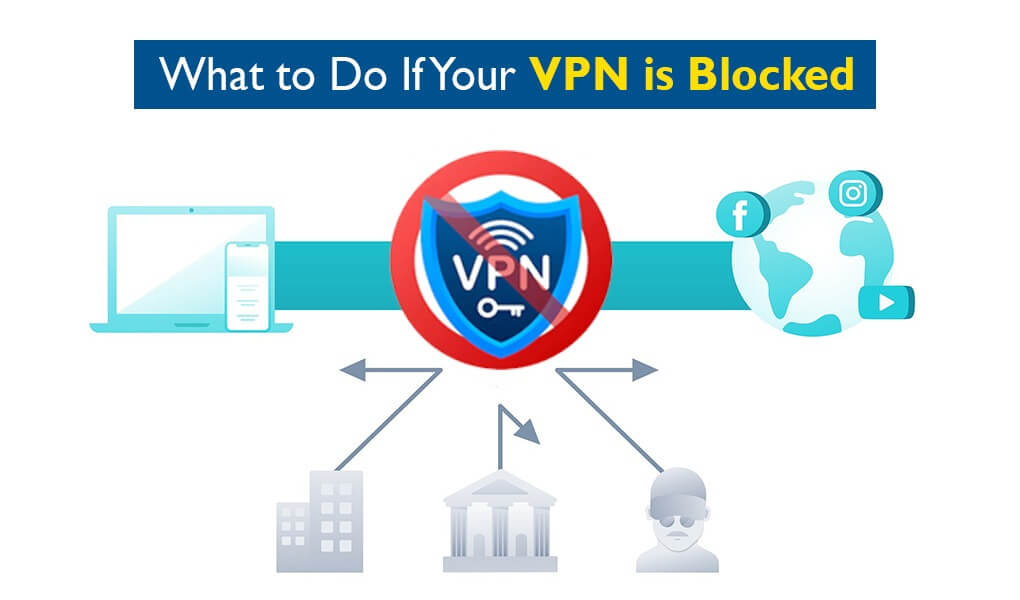VPNs are invaluable tools for remaining anonymous online, safeguarding your identity, and bypassing government censorship. Because of this, some networks will block VPN usage in order to keep users from being able to take advantage of these features.
Learn why VPNs are blocked and some handy methods to bypass VPN blocks so you can surf the Web in privacy no matter where you log on.
Why are VPNs Blocked?
There are a number of reasons why particular networks or services may block VPN usage.
School and business networks commonly block VPNs. This is usually to keep users from accessing blocked websites such as social media, as VPNs are commonly used to circumvent existing firewall restrictions. VPNs may also be blocked for security or legal liability reasons, since users may connect to VPNs to pirate copyrighted media or use them to evade the network’s security restrictions.
Streaming services such as Netflix also commonly block VPNs. This is often because VPNs are frequently used to get around regional blocks on content, allowing users to access content that isn’t ordinarily available in their countries. Some streaming platforms may also block VPNs in order to keep users from sharing accounts when they don’t live in the same area.
One of the most common reasons why VPNs are blocked is government censorship. Because VPNs can be used to evade government firewalls, governments that censor Internet usage will also block VPNs to prevent users from accessing prohibited websites.
Finally, because a minority of VPN users will abuse VPN services to conduct credit card fraud, online theft, hacking, DDoS attacks, and other forms of cybercrime, some financial and e-commerce sites, such as bank websites and payment processors like PayPal, may limit or block VPN access.
Techniques to Block VPN
Blocking VPNs requires that websites, services, and firewalls be able to identify VPN traffic. Here are some of the most common techniques to block VPN.
The first and most common method is blocking VPN traffic via a firewall. This can be done by identifying the specific VPN protocols being used and implementing firewall-level protection. This is most commonly deployed by the school and corporate networks.
Another common method of blocking VPNs is to block the IP addresses that are associated with VPN servers. This is done by creating a list of known VPN IP addresses and blocking those addresses at the firewall or by using a third-party tool that can do the job.
VPNs can also be blocked at the domain or app level. Since many VPNs are well-known, network administrators can simply add popular VPN providers to a list of blacklisted domains, preventing users from accessing them.
VPNs can also be blacklisted via port blocking. VPN protocols often use the same ports, such as port 443 or port 1194, so network administrators can halt VPN usage by preventing these ports from being accessed on the network.
Finally, deep packet inspection (DPI) is an extreme method of blocking VPNs, often used by governments. DPI technology allows an organization to inspect the data packets being transmitted over the network and identify VPN traffic based on specific characteristics. Once VPN traffic has been identified, it can be blocked or restricted.
How to Unblock a VPN
If you want to surf the Internet in privacy and keep others from snooping on your online activity, you’ll need to know how to defeat VPN blocking methods. Here are some methods to bypass VPN blocks.
1. Change your VPN server
Sometimes, the VPN block can be specific to a certain server or location. If this is the case, try connecting to a different server or location and see if that helps.
2. Change your VPN protocol
There are several different types of VPN protocols, such as PPTP, L2TP, and OpenVPN. If one protocol is being blocked, try switching to a different one to see if that fixes the problem.
3. Use a different port
Most VPNs allow you to connect using different ports. If the default port is blocked, try connecting through a different port. This may allow you to circumvent the block.
4. Use an obfuscated (stealth) VPN
Obfuscated VPNs, also known as stealth VPNs, disguise your VPN traffic as normal Internet traffic. This allows your traffic to evade firewalls that are using deep packet inspection. Not all VPNs offer an obfuscation option, but they are worth investing in if you are exceptionally concerned about privacy.
5. Use a Smart DNS service
A Smart DNS service works by redirecting certain types of Internet traffic through its own servers, allowing you to access blocked or restricted content. Using a Smart DNS service with your VPN may be required in order to use streaming services due to their increasingly sophisticated VPN blocking methods.
6. Use a static/dedicated IP address
If your network is blocking VPNs by IP address, purchasing a dedicated IP address from your VPN provider may allow you to circumvent the block. This is because since you are the only user of the IP address, your traffic will not appear suspicious to the firewall and thus it will be less likely to be blocked.
7. Use your mobile data
If you are trying to access your VPN through a school or work network, switching to your mobile network will allow you to circumvent the block, since you’ll be using your own cell phone network instead.
VPN Blocks: The Bottom Line
VPN blocks can be frustrating. VPNs are an important part of privacy in the modern world, and when you can’t use your VPN because of your network’s policies or government censorship, you might feel unsafe surfing the Internet.
With these tips, you’ll be able to get around VPN blocks and stay anonymous online!

